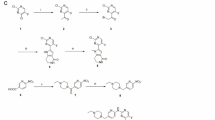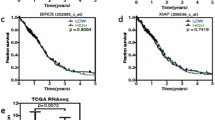Abstract
Purpose
Glioblastoma (GBM) is a very aggressive and lethal brain tumor with poor prognosis. Despite new treatment strategies, patients’ median survival is still lower than 1 year in most cases. The expression of the BUB gene family has demonstrated to be altered in a variety of solid tumors, pointing to a role as putative therapeutic target. The purpose of this study was to determine BUB1, BUB3, and BUBR1 gene expression profiles in glioblastoma and to analyze the effects of BUB1 and BUBR1 inhibition combined or not with Temozolomide and radiation in the pediatric SF188 GBM cell line.
Methods
For gene expression analysis, 8 cell lines and 18 tumor samples were used. The effect of BUB1 and BUBR1 inhibition was evaluated using siRNA. Apoptosis, cell proliferation, cell cycle kinetics, micronuclei formation, and clonogenic capacity were analyzed after BUB1 and BUBR1 inhibition. Additionally, combinatorial effects of gene inhibition and radiation or Temozolomide (TMZ) treatment were evaluated through proliferation and clonogenic capacity assays.
Results
We report the upregulation of BUB1 and BUBR1 expression and the downregulation of BUB3 in GBM samples and cell lines when compared to white matter samples (p < 0.05). Decreased cell proliferation and colony formation after BUB1 and BUBR1 inhibition were observed, along with increased micronuclei formation. Combinations with TMZ also caused cell cycle arrest and increased apoptosis. Moreover, our results demonstrate that BUB1 and BUBR1 inhibition sensitized SF188 cells to γ-irradiation as shown by decreased growth and abrogation of colony formation capacity.
Conclusion
BUB1 and BUBR1 inhibition decreases proliferation and shows radiosensitizing effects on pediatric GBM cells, which could improve treatment strategies for this devastating tumor. Collectively, these findings highlight the potentials of BUB1 and BUBR1 as putative therapeutic targets for glioblastoma treatment.


Similar content being viewed by others
References
Lim SK, Llaguno SRA, McKay RM, Parada LF (2011) Glioblastoma multiforme: a perspective on recent findings in human cancer and mouse models. BMB reports 44(3):158–64
Raysi Dehcordi S, De Paulis D, Marzi S, Ricci A, Cimini A, Cifone MG et al (2012) Survival prognostic factors in patients with glioblastoma: our experience. J Neurosurg Sci 56(3):239–45
Martinez R, Esteller M (2010) The DNA methylome of glioblastoma multiforme. Neurobiol Dis 39:40–46
Khalatbari MR, Hamidi M, Moharamzad Y (2011) Glioblastoma multiforme with very rapid growth and long-term survival in children: report of two cases and review of the literature. Childs Nerv Syst 27:1347–1352
MacDonald TJ, Aguilera D, Kramm CM (2011) Treatment of high-grade glioma in children and adolescents. Neuro-Oncology 1–10
Paugh BS, Qu C, Jones C, Liu Z, Asamowicz-Brice M, Zhang J et al (2010) Integrated molecular genetic profiling of pediatric high-grade gliomas reveals key differences with the adult disease. J Clin Oncol 28(18):3061–3068
Bax DA, Little SE, Gaspar N, Perryman L, Marshall L, Viana-Pereira M et al (2009) Molecular and phenotypic characterisation of paediatric glioma cell lines as models for preclinical drug development. PLoS One 4:1–9
Hoyt MA, Totis I, Roberts BTS (1991) Cerevisiae genes required for cell cycle arrest in response to loss of microtubule function. Cell 66:507–517
Li R, Murray AW (1991) Feedback control of mitosis in budding yeast. Cell 66:519–531
Medina-Redondo M, Meraldi P (2009) A life outside kinetochores for Bub1 kinases? Cell Cycle 8(2):3250–3256
Kops GJPL, Weaver BAA, Cleveland DW (2005) On the road to cancer: aneuploidy and the mitotic checkpoint. Nature Reviews 5:773–785
Musacchio A, Hardwick KG (2002) The spindle checkpoint: structural insights into dynamic signalling. Nat Rev Mol Cell Biol 3:731–41
Grabsch H, Takeno S, Parsons W, Pomjanski N, Boecking A, Gabbert HE et al (2003) Overexpression of the mitotic checkpoint genes BUB1, BUBR1, and BUB3 in the gastric cancer—association with tumor cell proliferation. J Pathol 200:16–22
Burum-Auensen E, DeAngelis PM, Schjolberg AR, Roislien J, Mjaland O, Clausen OPF (2008) Reduced level of the spindle checkpoint protein BUB1B is associated with aneuploidy in colorestal cancer. Cell Proliferation 41:645–659
Pinto M, Vieira J, Ribeiro FR, Soares MJ, Henrique R, Oliveira J et al (2008) Overexpression of the mitotic checkpoint genes BUB1 and BUBR1 is associated with genomic complexity in clear cell kidney carcinomas. Cell Oncol 30:389–395
Bie L, Zhao G, Cheng P, Rondeau G, Porwollik S, Ju Y et al (2011) The accuracy of survival time prediction for patients with glioma is improved by measuring mitotic spindle checkpoint gene expression. PLoS One 6(10):e25631
Valente V, Teixeira SA, Neder L, Okamoto OK, Oba-Shinjo SM, Marie SK et al (2009) Selection of suitable housekeeping genes for expression analysis in glioblastoma using quantitative RT-PCR. BMC Mol Biol 10:17
Livak KJ, Schmittgen TD (2001) Analysis of relative gene expression data using real-time quantitative PCR and the 2(−delta delta C(T)) method. Methods 25:402–408
Tao Y, Zhang P, Frascogna V, Lecluse Y, Auperin A, Bourhis J et al (2007) Enhancement of radiation response by inhibition of Aurora-A kinase using siRNA or a selective Aurora kinase inhibitor PHA680632 in p53-deficient cancer cells. Br J Cancer 97(12):1664–72
Franken NA, Rodermond HM, Stap J, Haveman J, van Bree C (2006) Clonogenic assay of cells in vitro. Nat Protoc 1:2315–2319
Fenech M, Chang WP, Kirsch-Volders M, Holland N, Bonassi S, Zeiger E (2003) HUMN project: detailed description of the scoring criteria for the cytokinesis-block micronucleus assay using isolated human lymphocyte cultures. Mutat Res 534:65–75
Kirsch-Volders M, Plas G, Elhajouji A, Lukamowicz M, Gonzalez L, Loock KV et al (2011) The in vitro MN assay in 2011: origin and fate, biological significance, protocols, high throughput methodologies and toxicological relevance. Arch Toxicol 85(8):873–99
Bai RY, Staedtke V, Riggins GJ (2011) Molecular targeting of glioblastoma: drug discovery and therapies. Trends in Mol Med Mar 17(6):301–12
Kaestner P, Aigner A, Bastians H (2011) Therapeutic targeting of the mitotic spindle checkpoint through nanoparticle-mediated siRNA delivery inhibits tumor growth in vivo. Cancer Lett 304:128–136
Kato T, Daigo Y, Aragaki M, Ishikawa K, Sato M, Kondo S, Kaji M (2011) Overexpression of MAD2 predicts clinical outcome in primary lung cancer patients. Lung Cancer 74(1):124–131
Holland AJ, Cleveland DW (2009) Boveri revisited: chromosomal instability, aneuploidy and tumorigenesis. Nat Rev Mol Cell Biol 10:478–487
Marchetti F, Venkatachalam S (2010) The multiple roles of Bub1 in chromosome segregation during mitosis and meiosis. Cell Cycle 9(1):58–63
Lira RCP, Miranda FA, Guimaraes MCM, Simoes RT, Donadi EA, Soares CP et al (2010) BUBR1 expression in benign oral lesions and squamous cell carcinomas: correlation with human papillomavirus. Oncol Rep 23:1027–1036
Logarinho E, Resende T, Torres C, Bousbaa H (2008) The human spindle assembly checkpoint protein Bub3 is required for the establishment of efficient kinetochore-microtubule attachments. Mol Biol Cell 19(4):1798–813
Pinto M, Soares MJ, Cerveira N, Henrique R, Ribeiro FR, Oliveira J et al (2007) Expression changes of the MAD mitotic checkpoint gene family in renal cell carcinomas characterized by numerical chromosome changes. Virchows Arch 450(4):379–85
Ando K, Kakeji Y, Kitao H, Limori M, Zhao Y, Yoshida R et al (2010) High expression of BUBR1 is one of the factors for inducing DNA aneuploidy and progression in gastric cancer. Cancer Sci 101(3):639–345
Hsieh PC, Chen YK, Tsai KB, Shieh TY, Chang YY, Chang JG et al (2010) Expression of BUBR1 in human oral potentially malignant disorders and squamous cell carcinoma. Oral Surg Oral Med Oral Pathol Oral Radiol Endod 109:257–267
Ricke RM, Jeganathan KB, Deursen JM (2011) Bub1 overexpression induces aneuploidy and tumor formation through Aurora B kinase hyperactivation. J Cell Biol 6:1–16
Ouyang B, Lan Z, Meadows J, Pan H, Fukasawa K, Li W et al (1998) Human Bub1: a putative spindle checkpoint kinase closely linked to cell proliferation. Cell Growth Differ 9:877–885
Spencer SL, Gerety RA, Pienta KJ, Forrest S (2006) Modeling somatic evolution in tumorigenesis. PLoS Comput Biol 2(8):e108, 0939–0947
Ohgaki H, Kleihues P (2009) Genetic alterations and signaling pathways in the evolution of gliomas. Cancer Sci Dec 100(12):2235–41
Kleihues P, Burger PC, Adalpe, KD, Brat, DJ, Biernat W, Bigner DD, Nakazato Y, Plate KH, Giangaspero F, Deimling AV, Ohgak H, Cavenee WK. Gliolastoma (2007) WHO classification of tumors of the central nervous system. In: Louis DN, Ohgaki H, Wiesther OD, Cavenee WK. (Eds). International Agency for Research on Cancer, Lion, 4th ed. pp. 33–49.
Kwiatkowski N, Jelluma N, Filippakopoulos P, Soundararajan M, Manak MS, Kwon M et al (2010) Small molecule kinase inhibitors provide insight into Mps1 cell cycle function. Nat Chem Biol 6(5):359–368
Kops GJPL, Foltz DR, Cleveland DW (2004) Lethality to human cancer cells through massive chromosome loss by inhibition of the mitotic checkpoint. PNAS 101(23):8699–8704
Gilbert MR (2011) Recurrent glioblastoma: a fresh look at current therapies and emerging novel approaches. Semin Oncol 38(Suppl 4):S21–33
Borges KS, Castro-Gamero AM, Moreno DA, da Silva SV, Brassesco MS, de Paula Queiroz RG et al (2012) Inhibition of Aurora kinases enhances chemosensitivity to temozolomide and causes radiosensitization in glioblastoma cells. J Cancer Res Clin Oncol 138(3):405–14
Chuah TL, Walker DG, Wei M, Scott S, Lavin MF (2012) Approaches to sensitizing glioblastoma to radiotherapy: use of lentiviral vectors. Int J Oncol 40(6):1963–9. doi:10.3892/ijo.2012.1409
Galbán S, Lemasson B, Williams TM, Li F, Heist KA, Johnson TD et al (2012) DW-MRI as a biomarker to compare therapeutic outcomes in radiotherapy regimens incorporating temozolomide or gemcitabine in glioblastoma. PLoS One 7(4):e35857
Reichert S, Reinboldt V, Hehlgans S, Efferth T, Rödel C, Rödel FA (2012) Radiosensitizing effect of artesunate in glioblastoma cells is associated with a diminished expression of the inhibitor of apoptosis protein survivin. Radiother Oncol 103(3):394–401
Yang C, Wang H, Xu Y, Brinkman KL, Ishiyama H, Wong ST et al (2012) The kinetochore protein Bub1 participates in the DNA damage response. DNA Repair (Amst) 11(2):185–91
Kaestner P, Bastians H (2010) Mitotic drug targets. J Cell Biochem 111:258–265
Mourón S, de Cárcer G, Seco E, Fernández-Miranda G, Malumbres M, Nebreda AR (2010) RINGO C is required to sustain the spindle-assembly checkpoint. J Cell Sci 123(Pt 15):2586–95
Wei Y, Multi S, Yang CR, Ma J, Zhang QH, Wang ZB et al (2011) Spindle assembly checkpoint regulates mitotic cell cycle progression during preimplantation embryo development. PLoS One 6(6):e21557
Wu YC, Yen WY, Yih LH (2008) Requirement of a functional spindle checkpoint for arsenite-induced apoptosis. J Cell Biochem 15(105(3)):678–87
Kienitz A, Vogel C, Morales I, Muller R, Bastians H (2005) Partial downregulation of MAD1 causes spindle checkpoint inactivation and aneuploidy, but does not confer resistance towards taxol. Oncogene 24:4301–4310
Gao F, Ponte JF, Papageorgis P, Levy M, Ozturk S, Lambert AW et al (2009) hBub1 deficiency triggers a novel p53 mediated early apoptotic checkpoint pathway in mitotic spindle damaged cells. Cancer Biol Ther 8(7):627–35
Morandi E, Severini C, Quercioli D, D’Ario G, Perdichizzi S, Capri M et al (2008) Gene expression time-series analysis of camptothecin effects in U87-MG and DBTRG-05 glioblastoma cell lines. Mol Cancer 11:7–66
Acknowledgments
We are grateful to BSc Veridiana Kiill Suazo for technical assistance. We also thank the Fundação de Apoio a Pesquisa do Estado de São Paulo (FAPESP; 2009/50118-2 and 2009/09305-3) and the Coordenação de Aperfeiçoamento de Pessoal de Nível Superior (CAPES) for financial support.
Author information
Authors and Affiliations
Corresponding author
Additional information
AG Morales and JA Pezuk contributed equally to this paper.
Rights and permissions
About this article
Cite this article
Morales, A.G., Pezuk, J.A., Brassesco, M.S. et al. BUB1 and BUBR1 inhibition decreases proliferation and colony formation, and enhances radiation sensitivity in pediatric glioblastoma cells. Childs Nerv Syst 29, 2241–2248 (2013). https://doi.org/10.1007/s00381-013-2175-8
Received:
Accepted:
Published:
Issue Date:
DOI: https://doi.org/10.1007/s00381-013-2175-8




